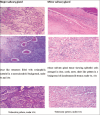Histomorphological comparison of pleomorphic adenoma in major and minor salivary glands of oral cavity: A comparative study
- PMID: 31942114
- PMCID: PMC6948026
- DOI: 10.4103/jomfp.JOMFP_91_19
Histomorphological comparison of pleomorphic adenoma in major and minor salivary glands of oral cavity: A comparative study
Abstract
Background and objectives: Pleomorphic adenoma, being the most common benign tumors of salivary gland, is morphologically characterized by a biphasic pattern containing the epithelial and mesenchymal components. The modified myoepithelial cells present are thought to play an important role in its histologic diversity by the formation of extracellular matrix. The aim of the present study was to observe, compare and correlate the histomorphological diversity of epithelial and stromal components along with different morphological cell types of modified myoepithelial cells.
Materials and method: Histomorphological features were compared in twenty cases of pleomorphic adenoma of major salivary glands and twenty cases of minor salivary glands using hematoxylin and eosin stains. The features were analyzed by observing under the light microscope.
Results: Statistical analysis showed significance of plasmacytoid cells, and squamous metaplasia was extensive with formation of keratin cyst-like structure resembling cystic pleomorphic adenoma, in minor salivary gland tumors.
Conclusion: Plasmacytoid cells, squamous cells and areas of hyalinization were observed predominantly in major salivary gland tumors compared to minor salivary glands. Keratin pearls were predominant in minor salivary gland tumors.
Keywords: Histopathology; keratin pearls; major salivary glands; minor salivary glands; pleomorphic adenoma.
Copyright: © 2019 Journal of Oral and Maxillofacial Pathology.
Conflict of interest statement
There are no conflicts of interest.
Figures


Similar articles
-
Pleomorphic adenoma with extensive squamous metaplasia and keratin cyst formations in minor salivary gland: a case report.J Appl Oral Sci. 2011 Apr;19(2):182-8. doi: 10.1590/s1678-77572011000200016. J Appl Oral Sci. 2011. PMID: 21552721 Free PMC article.
-
Oral cavity salivary gland pleomorphic adenoma: a histomorphological case series.Ann Diagn Pathol. 2024 Aug;71:152306. doi: 10.1016/j.anndiagpath.2024.152306. Epub 2024 Apr 9. Ann Diagn Pathol. 2024. PMID: 38614034
-
Pleomorphic adenomas of the salivary glands: retrospective multicentric study of 130 cases with emphasis on histopathological features.Eur Arch Otorhinolaryngol. 2017 Jan;274(1):543-551. doi: 10.1007/s00405-016-4253-5. Epub 2016 Aug 12. Eur Arch Otorhinolaryngol. 2017. PMID: 27520570
-
[Pleomorphic adenoma of salivary glands: diagnostic pitfalls and mimickers of malignancy].Cesk Patol. 2012 Oct;48(4):179-83. Cesk Patol. 2012. PMID: 23121026 Review. Czech.
-
Myoepithelial cells in salivary gland tumors--revisited.Head Neck Surg. 1985 May-Jun;7(5):395-408. doi: 10.1002/hed.2890070509. Head Neck Surg. 1985. PMID: 2833468 Review.
Cited by
-
Case Series: Pleomorphic adenoma in minor salivary gland.F1000Res. 2024 Jun 28;13:243. doi: 10.12688/f1000research.146682.2. eCollection 2024. F1000Res. 2024. PMID: 38993262 Free PMC article.
-
Correlation of Clinical and Histopathological Features of Salivary Pleomorphic Adenoma.J Dent (Shiraz). 2023 Dec 1;24(4):404-409. doi: 10.30476/dentjods.2022.96307.1933. eCollection 2023 Dec. J Dent (Shiraz). 2023. PMID: 38149235 Free PMC article.
-
"Pleomorphic adenoma in salivary glands: Insights from a 100-patient analysis".J Oral Maxillofac Pathol. 2024 Jan-Mar;28(1):42-48. doi: 10.4103/jomfp.jomfp_452_23. Epub 2024 Apr 15. J Oral Maxillofac Pathol. 2024. PMID: 38800432 Free PMC article.
-
Salivary Gland Pleomorphic Adenomas Presenting With Extremely Varied Clinical Courses. A Single Institution Case-Control Study.Front Oncol. 2021 Jan 8;10:600707. doi: 10.3389/fonc.2020.600707. eCollection 2020. Front Oncol. 2021. PMID: 33489904 Free PMC article.
-
Retrospective Analysis of Histopathological Reports of Salivary Gland Pleomorphic Adenomas in Tanzania.East Afr Health Res J. 2024;8(2):195-199. doi: 10.24248/eahrj.v8i2.781. Epub 2024 Jun 26. East Afr Health Res J. 2024. PMID: 39296770 Free PMC article.
References
-
- Ito FA, Jorge J, Vargas PA, Lopes MA. Histopathological findings of pleomorphic adenomas of the salivary glands. Med Oral Patol Oral Cir Bucal. 2009;14:E57–61. - PubMed
-
- Rajendran R, Sivapathasundharam B. 5th ed. New Delhi (India): Elseiver; 2007. Shafer's Text of Oral Pathology; p. 311.
-
- Melkundi M, Babaji P, Saikhedkar R, Chaluvaiah MB. Pleomorphic adenoma of parotid gland: A case report. OMPJ. 2012;3:228–31.

